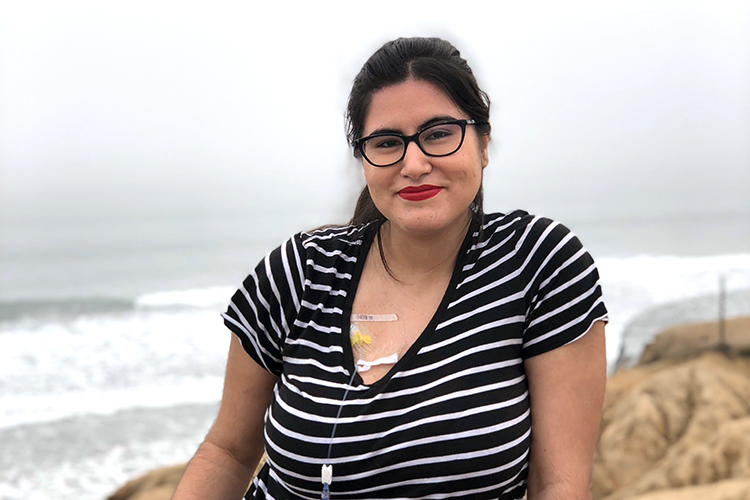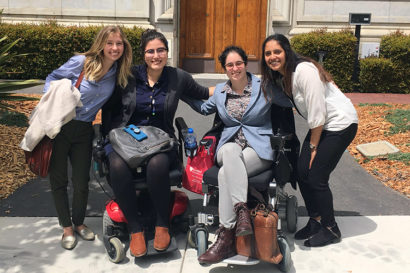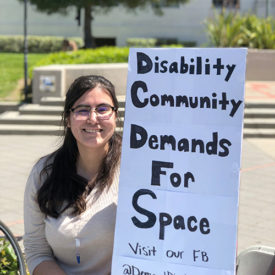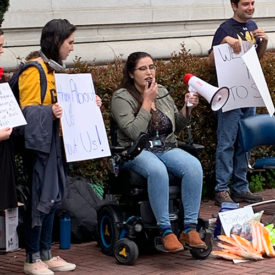I’m a Berkeleyan: Student Alena Morales on the fight for campus’s new disability cultural center
"We held a protest on campus at one point, and one of our chants was, ‘What do we want? A community center! When do we want it? Ten years ago!’" said Morales
October 6, 2020

Alena Morales in a senior in the registered dietitian program at UC Berkeley with a minor in disability studies. She has been advocating for a disability cultural center since she arrived on campus as a first-year student in 2016. (Photo by Brianna Basa)
“Something that I’ve heard around the disability community, that I also feel as a disabled person, is that society is not built for me. Not only do we spend a lot of energy navigating access barriers and having to get creative with navigating the world, but it’s also really exhausting to be disabled and then having to prove that you’re capable and that you can keep up with this world that’s not built for you. It’s draining.
As a first-year student at Berkeley in 2016, I went to the Disabled Students’ Program and got my accommodations, but there wasn’t a place where I could go and feel community in an identity-based or sociocultural way. All of the disability spaces on campus are more compliance-based.

From left: Jillian Free, Alena Morales, Katie Savin and Nidhi Chandra formed the Disabled Student Leaders Coalition in 2017. The group fought for and won a space on campus where students, staff and faculty with disabilities can connect with others with similar experiences, and manage their disabilities in a comfortable, open space. (Photo courtesy of Alena Morales)
I’m a wheelchair user and I have an IV port — I get infusions every day. I find myself hiding little routines that I do to just manage my disability, like changing my IV bag: I do it in the bathroom. If the world were built for disabled people, I would probably feel comfortable doing it anywhere, but because it’s not, I don’t.
There are almost 4,000 people in the Disabled Students’ Program, and surveys have shown that only a small percentage of disabled students on campus actually get accommodations. So, think about it: If 20% of the U.S. population is disabled, I would assume it’s the same at Berkeley, so most likely at least 8,000 students on campus have disabilities. It’s like, why was a system built in which someone in a community with 8,000 people feels like they’re the only one dealing with a disability? It really goes to show how these spaces haven’t been prioritized and how underground disability spaces are.
The first time that I met Ph.D. candidate Katie Savin, we talked about how she has an insulin pump, and we were like, ‘We need to start having some pump pride.’ I changed my IV bag in front of her. Just being able to talk about our disabilities was really nice.

“The fact that we have a disability community space this fall is amazing,” said Morales, “but it’s something that we’ve needed for a while, and it’s really long overdue.” (Photo by Nicholas Olivares)
Before we met, we had both been talking about wanting a disability cultural center on campus — a comfortable space where people could go to be unapologetically disabled. So, we, along with two other students — Jillian Free and Nidhi Chandra — formed the Disabled Student Leaders Coalition. (The coalition has since been disbanded and absorbed into the ASUC Disabled Students Committee.) We wrote a proposal to Chancellor Christ in 2017, then met with her and laid it all out for her, and she was supportive. Still, it took more advocacy work for us to secure a space on campus.
We held several town halls, where the campus community talked about what they wanted in a cultural space. We really wanted the space to be universally accessible — not just physically accessible, but a space that’s going to make as many community members feel as comfortable as possible. And because there are so many categories of disability, we couldn’t assume to know what everyone would want.

During a protest on campus, Morales led a chant that went, “What do we want? A community center! When do we want it? Ten years ago!” (Photo by Cynthia Basa-Morales)
This fall — on the 30th anniversary of the Americans with Disabilities Act — we finally got our space in the Hearst Field Annex. Although getting it up and running has been stalled, as most of the campus community is studying and working remotely right now because of the coronavirus, we have a plan, and hopefully we can start building the center soon.
We want the cultural center to be a place where we can connect with other community members with similar experiences, and where we can do what we need to do to manage our disabilities in an open space and feel proud about who we are.
We have plans to have a common room, where people can just hang out and study and stuff, and a conference room, where we can have advocacy meetings and host clubs. There will be an office for a full-time staff member, who will help with event planning and programs, and an office for graduate students, where they can meet with their advisers and hang out. And then, we want a quiet, soundproof room, where people who are hard of hearing can crank their music, or neurodivergent folks and folks on the spectrum can have some peace and quiet, or scream and be loud — whatever they need to do to get through the day.

The new disability cultural center will be in the Hearst Field Annex on campus. (UC Berkeley photo by Steve McConnell)
The cultural center is a collective project — there are a lot of other disabled students and some super-fierce disabled faculty and staff who are involved in it as well. And it’s not the first time the community at Berkeley has rallied for one; many advocates have fought for one over the past several decades.
We held a protest on campus at one point, and one of our chants was, ‘What do we want? A community center! When do we want it? Ten years ago!’ So, the fact that we have a space this fall is amazing, but it’s something that we’ve needed for a while, and it’s really long overdue.”